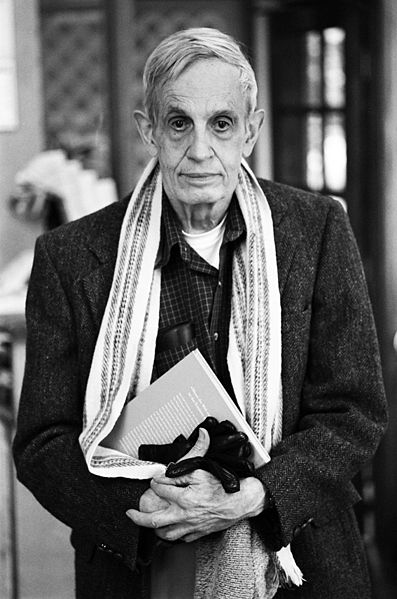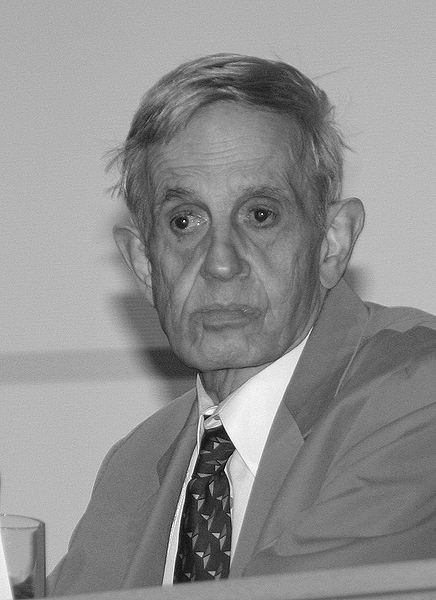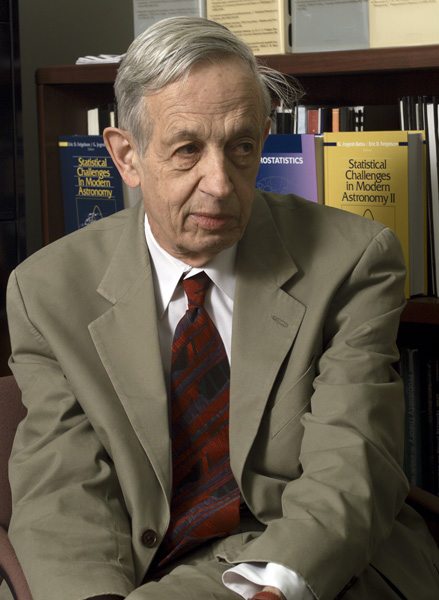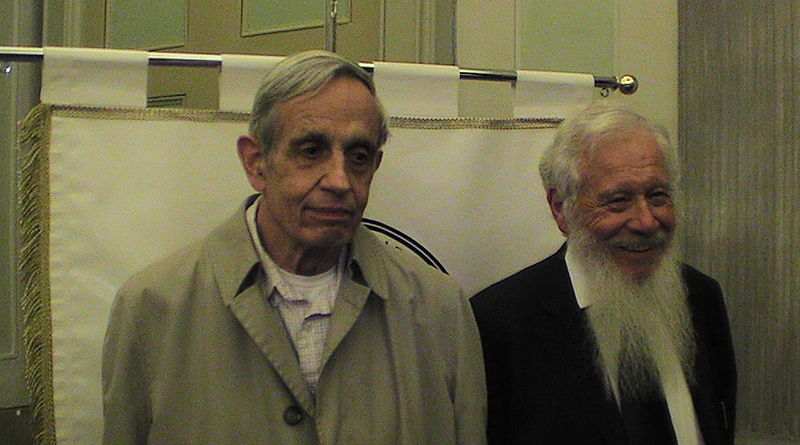<Back to Index>
- Mathematician John Forbes Nash, Jr., 1928
- Photographer Alberto Henschel, 1827
- Brazilian Statesman José Bonifácio de Andrada e Silva, 1763
PAGE SPONSOR



John Forbes Nash, Jr. (born June 13, 1928) is an American mathematician whose works in game theory, differential geometry, and partial differential equations have provided insight into the forces that govern chance and events inside complex systems in daily life. His theories are used in market economics, computing, evolutionary biology, artificial intelligence, accounting, politics and military theory. Serving as a Senior Research Mathematician at Princeton University during the latter part of his life, he shared the 1994 Nobel Memorial Prize in Economic Sciences with game theorists Reinhard Selten and John Harsanyi.
Nash is the subject of the Hollywood movie A Beautiful Mind. The film, loosely based on the biography of the same name, focuses on Nash's mathematical genius and struggle with paranoid schizophrenia.
Nash was born on June 13, 1928, in
Bluefield, West Virginia. His father, after whom he is named, was an electrical engineer for the Appalachian Electric Power Company.
His mother, Margaret, had been a school teacher prior to marriage.
Nash's parents pursued opportunities to supplement their son's
education with encyclopedias and even allowed him to take advanced
mathematics courses at a local college while still in high school. Nash
accepted a scholarship to Carnegie Institute of Technology (now Carnegie Mellon University) and graduated with a Master's Degree in only three years.
- Nash, JF (1950), "Equilibrium Points in N-person Games", Proceedings of the National Academy of Sciences 36;
- "The Bargaining Problem", Econometrica (18): 155–62, 1950;
- Nash, J. (1951), "Non-cooperative Games", Annals of Mathematics 54 (54): 286–95;
- "Two-person Cooperative Games", Econometrica (21): 128–40, 1953.
Nash did ground-breaking work in the area of real algebraic geometry:
- "Real algebraic manifolds", Annals of Mathematics (56): 405–21, 1952.
His work in mathematics includes, for example, the Nash embedding theorem, which shows that any abstract Riemannian manifold can beisometrically realized as a submanifold of Euclidean space. He also made significant contributions to the theory of nonlinear parabolic partial differential equations, and to singularity theory.
In the book A Beautiful Mind, author Sylvia Nasar explains that Nash was working on proving a theorem involving elliptic partial differential equations when, in 1956, he suffered a severe disappointment when he learned of an Italian mathematician, Ennio de Giorgi, who had published a proof a couple of months before Nash achieved his proof. Each took different routes to get to their solutions. The two mathematicians met each other at the Courant Institute of Mathematical Sciences of New York University during the summer of 1956. It has been speculated that if only one of them had solved the problem, he would have been given the Fields Medal for the proof.
Per Nash's biography, from 1951 onwards, he had a liaison with a nurse, Eleanor Stier. She bore a child named John David Stier. Though Nash had thought of marrying her, he later decided against it and left them.
In 1951, Nash went to the Massachusetts Institute of Technology as a C.L.E. Moore Instructor in the mathematics faculty. There, he met Alicia Lopez - Harrison de Lardé (born January 1, 1933), a physics student from El Salvador, whom he married in February 1957. She admitted Nash to a mental hospital in 1959 for schizophrenia; their son, John Charles Martin Nash, was born soon afterward, but remained nameless for a year because his mother felt that her husband should have a say in the name. Nash and de Lardé divorced in 1963, though after his final hospital discharge in 1970 Nash lived in de Lardé's house. They were remarried in 2001. Nash has been a longtime resident of West Windsor Township, New Jersey.
Nash began to show signs of extreme paranoia and his wife later described his behavior as erratic, as he began speaking of characters like Charles Herman and William Parcher who were putting him in danger. Nash seemed to believe that all men who wore red ties were part of a communist conspiracy against him. Nash mailed letters to embassies in Washington, D.C., declaring that they were establishing a government.
He was admitted to the McLean Hospital, April – May 1959, where he was diagnosed with paranoid schizophrenia. The clinical picture is dominated by relatively stable, often paranoid, fixed beliefs that are either false, over - imaginative or unrealistic, usually accompanied by experiences of seemingly real perception of something not actually present — particularly auditory and perceptional disturbances, a lack of motivation for life, and mild clinical depression. Upon his release, Nash resigned from MIT, withdrew his pension, and went to Europe, unsuccessfully seeking political asylum in France and East Germany. He tried to renounce his U.S. citizenship. After a problematic stay in Paris and Geneva, he was arrested by the French police and deported back to the United States at the request of the U.S. government.
In 1961, Nash was committed to the New Jersey State Hospital at Trenton. Over the next nine years, he spent periods in psychiatric hospitals, where, aside from receiving antipsychotic medications, he was administered insulin shock therapy.
Although he took prescribed medication, Nash wrote later that he only took it under pressure. After 1970, he was never committed to the hospital again and refused any medication. According to Nash, the film A Beautiful Mind inaccurately showed him taking new atypical antipsychotics during this period. He attributed the depiction to the screenwriter (whose mother, he notes, was a psychiatrist), who was worried about encouraging people with the disorder to stop taking their medication. Others, however, have questioned whether the fabrication obscured a key question as to whether recovery from problems like Nash's can actually be hindered by such drugs, and Nash has said they are overrated and that the adverse effects are not given enough consideration once someone is considered mentally ill. According to Sylvia Nasar, author of the book A Beautiful Mind, on which the movie was based, Nash recovered gradually with the passage of time. Encouraged by his then former wife, de Lardé, Nash worked in a communitarian setting where his eccentricities were accepted. De Lardé said of Nash, "it's just a question of living a quiet life".
Nash dates the start of what he terms "mental disturbances" to the early months of 1959 when his wife was pregnant. He has described a process of change "from scientific rationality of thinking into the delusional thinking characteristic of persons who are psychiatrically diagnosed as 'schizophrenic' or 'paranoid schizophrenic'" including seeing himself as a messenger or having a special function in some way, and with supporters and opponents and hidden schemers, and a feeling of being persecuted, and looking for signs representing divine revelation. Nash has suggested his delusional thinking was related to his unhappiness, and his striving to feel important and be recognized, and to his characteristic way of thinking such that "I wouldn't have had good scientific ideas if I had thought more normally." He has said, "If I felt completely pressureless I don't think I would have gone in this pattern". He does not see a categorical distinction between terms such as schizophrenia and bipolar disorder. Nash reports that he did not hear voices until around 1964, later engaging in a process of rejecting them. Nash reports that he was always taken to hospitals against his will, and only temporarily renounced his "dream - like delusional hypotheses" after being in a hospital long enough to decide to superficially conform, behave normally or experience "enforced rationality". Only gradually on his own did he "intellectually reject" some of the "delusionally influenced" and "politically - oriented" thinking as a waste of effort. However, by 1995, he felt that although he was "thinking rationally again in the style that is characteristic of scientists," he felt more limited.
At Princeton, campus legend Nash became "The Phantom of Fine Hall" (Princeton's mathematics center), a shadowy figure who would scribble arcane equations on blackboards in the middle of the night. The legend appears in a work of fiction based on Princeton life, The Mind - Body Problem, by Rebecca Goldstein.
In 1978, Nash was awarded the John von Neumann Theory Prize for his discovery of non-cooperative equilibria, now called Nash equilibria. He won the Leroy P. Steele Prize in 1999.
In 1994, he received the Nobel Memorial Prize in Economic Sciences (along with John Harsanyi and Reinhard Selten) as a result of his game theory work as a Princeton graduate student. In the late 1980s, Nash had begun to use email to gradually link with working mathematicians who realized that he was the John Nash and that his new work had value. They formed part of the nucleus of a group that contacted the Bank of Sweden's Nobel award committee and were able to vouch for Nash's mental health ability to receive the award in recognition of his early work.
As of 2011 Nash's recent work involves ventures in advanced game theory, including partial agency, that show that, as in his early career, he prefers to select his own path and problems. Between 1945 and 1996, he published 23 scientific studies.
Nash has suggested hypotheses on mental illness. He has compared not thinking in an acceptable manner, or being "insane" and not fitting into a usual social function, to being "on strike" from an economic point of view. He has advanced evolutionary psychology views about the value of human diversity and the potential benefits of apparently nonstandard behaviors or roles.
Nash has developed work on the role of money in society. Within the framing theorem that people can be so controlled and motivated by money that they may not be able to reason rationally about it, he has criticized interest groups that promote quasi - doctrines based on Keynesian economics that permit manipulative short term inflation and debt tactics that ultimately undermine currencies. He has suggested a global "industrial consumption price index" system that would support the development of more "ideal money" that people could trust rather than more unstable "bad money". He notes that some of his thinking parallels economist and political philosopher Friedrich Hayek's thinking regarding money and a nontypical viewpoint of the function of the authorities.
Nash received an honorary degree, Doctor of Science and Technology from Carnegie Mellon University in 1999; an honorary degree in economics from the University of Naples Federico II on March 19, 2003; an honorary doctorate in economics from the University of Antwerp in April 2007, and was keynote speaker at a conference on Game Theory. He has also been a prolific guest speaker at a number of world - class events, such as the Warwick Economics Summit in 2005 held at the University of Warwick.
Nash has an Erdős number of 4.
